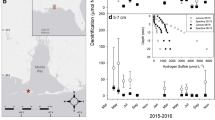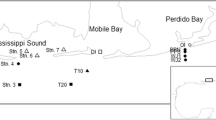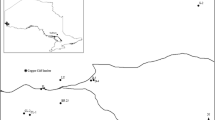Abstract
The extensive spread ofPhragmites australis throughout brackish marshes on the East Coast of the United States is a major factor governing management and restoration decisions because it is assumed that biogeochemical functions are altered by the invasion. Microbial activity is important in providing wetland biogeochemical functions such as carbon and nitrogen cycling, but there is little known about sediment microbial communities inPhragmites marshes. Microbial populations associated with invasivePhragmites vegetation and with native salt marsh cordgrass,Spartina alterniflora, may differ in the relative abundance of microbial taxa (community structure) and in the ability of this biota to decompose organic substrates (community biogeochemical function). This study compares sediment microbial communities associated withPhragmites andSpartina vegetation in an undisturbed brackish marsh near Tuckerton, New Jersey (MUL), and in a brackish marsh in the anthropogenically affected Hackensack meadowlands (SMC). We use phospholipid fatty acid (PLFA) analysis and enzymataic activity to profile sediment microbial communities associated with both plants in each site. Sediment analyses include bulk density, total organic matter, and root biomass. PLFA profiles indicate that the microbial communities differ between sites with the undisturbed site exhibiting greater fatty acid richness (62 PLFA recovered from MUL versus 38 from SMC). Activity of the 5 enzymes analyzed (β-glucosidase, acid phosphatase, chitobiase, and 2 oxidases) was higher in the undisturbed site. Differences between vegetation species as measured by Principal Components Analysis were significantly greater at the undisturbed MUL site than at SMC, and patterns of enzyme activity and PLFAs did not correspond to patterns of root biomass. We suggest that in natural wetland sediments, macrophyte rhizosphere effects influence the community composition of sediment microbial populations. Physical and chemical site disturbances may impose limits on these rhizosphere effects, decreasing sediment microbial diversity and potentially, microbial biogeochemical functions.
Similar content being viewed by others
Literature Cited
Adrianes, P. andT. Vogel. 1995. Biological treatment of chlorinated organics, p. 435–486.In L. Y. Young and C. E. Cerniglia (eds.), Microbial Transformation and Degradation of Toxic Organic Chemicals. John Wiley and Sons, New York.
Ajwa, H. A., C. J. Dell, andC. W. Rice. 1999. Changes in enzyme activities and microbial biomass of tallgrass prairie soil as related to burning and nitrogen fertilization.Soil Biology and Biochemistry 31:769–777.
Alder, A. C., M. M. Häggblom, S. R. Oppenheimer, andL. Y. Young. 1993. Reductive dechlorination of polychlorinated biphenyls in freshwater and marine sediments.Environmental Science and Technology 27:530–538.
Armstrong, J., W. Armstrong, P. M. Beckett, J. E. Halder, S. Lythe, R. Holt, andA. Sinclair. 1996. Pathways of aeration and the mechanisms and beneficial effects of humidity- and venturi-induced convections inPhragmites australis (Cav.) Trin. ex Steud.Aquatic Botany 54:177–197.
Armstrong, W., D. Cousins, J. Armstrong, D. W. Turner, andP. M. Beckett. 2000. Oxygen distribution in wetland plant roots and permeability barriers to gas-exchange with the rhizosphere: A microelectrode and modeling study withPhragmites australis.Annals of Botany 86:687–703.
Bergholz, P. W., C. E. Bagwell, andC. R. Lovell. 2001. Physiological diversity of rhizoplane diazotrophs of the saltmeadow cordgrass,Spartina patens: Implications for host specific ecotypes.Microbial Ecology 42:466–473.
Binkley, D. andC. Giardina. 1998. Why do tree species affect soils? The warp and wood of tree-soil interactions.Biogeochemistry 42:89–106.
Borga, P., M. Nilsson, andA. Tunlid. 1994. Bacterial communities in peat in relation to botanical composition as revealed by phospholipid fatty acid analysis.Soil Biology and Biochemistry 26:841–848.
Brix, H., B. K. Sorrell, andP. T. Orr. 1992. Internal pressurization and convective gas flow in some emergent freshwater macrophytes.Limnology and Oceanography 37:1420–1433.
Dick, W. A. andM. A. Tabatabai. 1993. Significance and potential uses of soil enzymes, p. 95–127.In F. B. Metting, Jr. (ed.), Soil Microbial Ecology, Marcel Dekker, New York.
Ehrenfeld, J. G. 2001. Plant-soil interactions, p. 689–709.In S. Levin (ed.), Encyclopedia of Biodiversity. Academic Press, San Diego, California.
Eivazi, F. andM. R. Bayan. 1996. Effects of long-term prescribed burning on the activity of select soil enzymes in an oak-hickory forest.Canadian Journal of Forest Research 26:1799–1804.
Frankenberger, Jr.,W. T. andW. A. Dick. 1983. Relationships between enzyme activities and microbial growth and activity indices in soil.Soil Society of American Journal 47:945–951.
Gandy, E. L. andD. C. Yoch. 1988. Relationship between nitrogen-fixing sulfate reducers and fermenters in salt marsh sediments and roots ofSpartina alterniflora.Applied and Environmental Microbiology 54:2031–2036.
Garland, J. 1996. Patterns of potential C source utilization by rhizosphere communities.Soil Biology and Biochemistry 28:223–230.
Grayston, S. J., C. D. Wang, A. C. Campbell, andA. C. Edwards. 1998. Selective influence of plant species on microbial diversity in the rhizosphere.Soil Biology and Biochemistry 30:369–378.
Grosse, W., J. Armstrong, andW. Armstrong. 1996. A history of pressurized gas-flow studies in plants.Aquatic Botany 54:87–100.
Häggblom, M. M., V. K. Knight, andL. J. Kerkhof. 2000. Anaerobic decomposition of halogenated aromatic compounds.Environmental Pollution 107:199–207.
Hobbie, S. E. 1992. Effects of plant species on nutrient cycling.Trends in Ecology and Evolution 10:336–339.
Howes, B. L., R. W. Howarth, J. M. Teal, andI. Valiela. 1981. Oxidation-reduction potentials in a salt marsh: Spatial patterns and interactions with primary production.Limnology and Oceanography 26:350–360.
Howes, B. L. andJ. M. Teal. 1994. Oxygen loss fromSpartina alterniflora and its relationship to salt marsh oxygen balance.Oecologia 97:431–438.
Hwang, B. L. andJ. T. Morris. 1991. Evidence for hygrometric pressurization in the internal gas space ofSpartina alterniflora.Plant Physiology 96:166–171.
Kang, H., C. Freeman, D. Lee, andW. J. Mitsch. 1998. Enzyme activities in constructed wetlands: Implications for water quality amelioration.Hydrobiologia 368:231–235.
Karthikeyan, S., G. M. Wolfaardt, D. R. Korber, andD. E. Caldwell. 1999. Functional and structural responses of a degradative microbial community to substrates with varying degrees of complexity in chemical structure.Microbial Ecology 38:215–224.
Kennish, M. J. 1992. Ecology of Estuaries: Anthropogenic Effects. CRC Press, Boca Raton, Florida.
King, J. D., D. C. White, andC. W. Taylor. 1977. Use of lipid composition and metabolism to examine structure and activity of estuarine detrital microflora.Applied Environmental Microbiology 33:1177–1183.
Kourtev, P. S., J. G. Ehrenfeld, and M. Haggblom. In press. Exotic plant species alter microbial structure and function in the soil.Ecology.
Kuperman, R. G. andM. M. Carreiro. 1997. Soil heavy metal concentrations, microbial biomass and enzyme activities in a contaminated grassland ecosystem.Soil Biology and Biochemistry 29:179–190.
Lovell, C. R., M. J. Friez, J. W. Longshore, andC. E. Bagwell. 2001. Recovery and phylogenetic analysis of NifH sequences from diazotrophic bacteria associated with dead aboveground biomass ofSpartina alterniflora.Applied and Environmental Microbiology 67:5308–5314.
Ludemann, H., I. Arth, andW. Liesack. 2000. Spatial changes in the bacterial community structure along a vertical oxygen gradient in flooded paddy soil cores.Applied and Environmental Microbiology 66:754–762.
Meyerson, L. A., K. Saltonstall, L. Windham, E. Kiviat, andS. Findlay. 2000. A comparison ofPhragmites australis in freshwater and brackish marsh environments in North America.Wetland Ecological Management 9:89–103.
Moller, S., D. R. Korber, G. M. Wolfaardt, S. Molin, andD. E. Caldwell. 1997. Impact of nutrient composition on a degradative biofilm community.Applied and Environmental Microbiology 63:2432–2438.
Nannipieri, P., S. Greco, andB. Ceccanti. 1990. Ecological significance of the biological activity in soil, p. 293–355.In S. G. Bollag (ed.), Soil Biochemistry, Volume 6. Marcel Dekker, Inc., New York.
Piceno, Y. M. andC. R. Lovell. 2000. Stability in natural bacterial communities: II. Plant resource allocation effects on rhizosphere diazotroph assemblage composition.Microbial Ecology 39:41–48.
Piceno, Y. M., P. Noble, andC. Lovell. 1999. Spatial and temporal assessment of diazotroph assemblage composition in vegetation salt marsh sediments using denaturing, gradient gel electrophoresis analysis.Microbial Ecology 38:157–167.
Quinn, J. R. 1997. Fields of Sun and Grass. Rutgers University Press, New Brunswick, New Jersey.
Rice, D., J. Rooth, andJ. C. Stevenson. 2000. Colonization and expansion ofPhragmites australis in upper Chesapeake Bay tidal marshes.Wetlands 20:280–299.
Rooth, J. E. andJ. C. Stevenson. 2000. Sediment deposition patterns inPhragmites australis communities: Implications for coastal areas threatened by rising sea-level.Wetlands Ecology and Management 8:173–183.
Shackle, V. J., C. Freeman, andB. Reynolds. 2000. Carbon supply and the regulation of enzyme activity in constructed wetlands.Soil Biology and Biochemistry 32:1935–1940
Sinsabaugh, R. 1994. Enzymic analysis of microbial pattern and process.Biology and Fertility of Soils 17:69–74.
Sinsabaugh, R. L., R. K. Antibus, A. E. Linkins, C. A. McClaugherty, L. Rayburn, D. Repert, andT. Weiland. 1993. Wood decomposition: Nitrogen and phosphorus dynamics in relation to extracellular enzyme activity.Ecology 74:1586–1593.
Sinsabaugh, R. L. andD. L. Moorhead. 1994. Resource allocation to extracellular enzyme production: A model for nitrogen and phosphorus control of litteer decomposition.Soil Biology and Biochemistry 26:1305–1311.
Valiela, I., J. M. Teal, andN. Y. Persson. 1976. Production and dunamics of experimentally enriched salt marsh vegetation: Belowground biomass.Limnology and Oceanography 21:245–252.
Wainwright, S. C., M. P. Weinstein, K. W. Able, andC. A. Currin. 2000. Relative importance of benthic microalgae, phytoplankton and the detritus of smooth cordgrass,Spartina alterniflora, and the common reed,Phragmites australis, to brackish-marsh food webs.Marine Ecology Progress Series 200:77–91.
Waldrop, M. P., T. C. Balser, andM. K. Firestone. 2000. Linking microbial community composition to function in a tropical soil.Soil Biology and Biochemistry 32:1837–1846.
Weinstein, M. P. andJ. H. Balletto. 1999. Does the common reed,Phragmites australis, affect essential fish habitat?Estuaries 22:793–802.
Weis, J. S. andP. Weis. 2000. Behavioral responses and interactions of estuarine animals with an invasive marsh plant: A laboratory analysis.Biological Invasions 2:305–314.
Westover, K. M., A. C. Kennedy, andS. E. Kelley. 1997. Patterns of rhizosphere microbial community structure associated with co-occurring plant species.Journal of Ecology 85:863–873.
White, D. C., W. M. Davis, J. S. Nickels, J. D. King, andR. J. Bobbie. 1979. Determination of the sedimentary microbial biomass by extractible lipid phosphate.Oecologia 40:51–62.
White, D. C., H. C. Pinkart, andD. B. Ringelberg. 1996. Biomass measurement: Biochemical approaches, p. 91–101.In C. J. Hurst, G. R. Knudsen, M. J. McInerney, L. D. Stetzenbach, and M. V. Walter (eds.), Manual of Environmental Microbiology. ASM Press, Washington, D.C.
Windham, L. 2001. Comparison of biomass production and decomposition betweenPhragmites australis (common reed) andSpartina patens (salt hay grass) in brackish tidal marshes of New Jersey, USA.Wetlands 21:179–188.
Windham, L. and J. G. Ehrenfeld. In press. Conflicting effects and the net impact of a plant invasion on nitrogen cycling processes within brackish tidal marshes.Ecological Applications.
Wolfaardt, G. M., J. R. Lawrence, R. D. Robarts, S. J. Caldwell, andD. E. Caldwell. 1994. Multicellular organization in a degradative biofilm community.Applied and Environmental Microbiology 60:434–446.
Sources of Unpublished Materials
Bart, D. Personal Communication. Rutgers University, New Brunswick, New Jersey.
New Jersey Meadowlands Commission. Unpublished Data. 1 DeKorte Park Plaza, Lyndhurst, New Jersey.
Weis, J. Personal Communication. University, New Brunswick, New Jersey.
Author information
Authors and Affiliations
Corresponding author
Rights and permissions
About this article
Cite this article
Ravit, B., Ehrenfeld, J.G. & Haggblom, M.M. A comparison of sediment microbial communities associated withPhragmites australis andSpartina alterniflora in two brackish wetlands of New Jersey. Estuaries 26, 465–474 (2003). https://doi.org/10.1007/BF02823723
Received:
Revised:
Accepted:
Issue Date:
DOI: https://doi.org/10.1007/BF02823723




